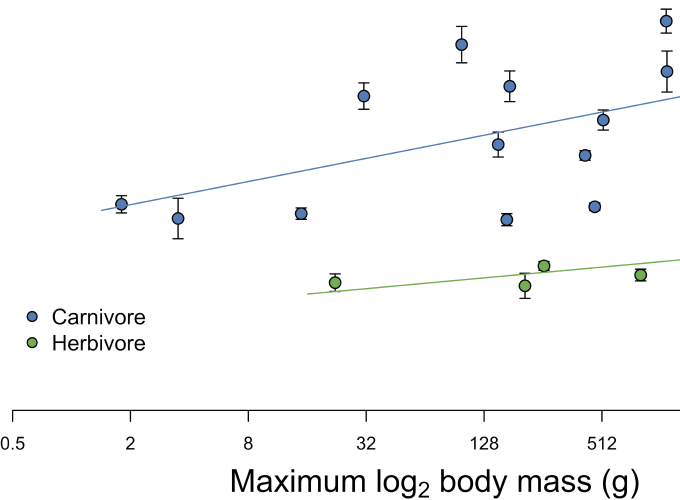Despite a strong focus on understanding patterns in the diversity, behaviour and functional roles of fish on coral reefs, we know far less about how fish communities are structured. In most aquatic communities, gape limitation and ontogenetic niche shifts produce communities that are size structured, where predators are larger than their prey. Our expectation is that reef fish communities should also be size structured, though this has not been formally tested. In a paper published in a special body size themed issue of the Canadian Journal of Fisheries & Aquatic Sciences, myself and Dr. Julia Baum examined the case for size structuring in the coral reef fish community at Kiritimati Atoll.
Size-structured communities are characterised by two major patterns. First, there is a negative relationship between abundance and body size (or size spectrum), due to the inefficiency of energy transfer between trophic levels that constrains the abundance of predators to be lower that that of their prey. Second, trophic position will increase with body size, reflecting the tight correlation between an individual’s body size and its position in the food web.
We examined the community structure at Kiritimati (Christmas) Island, the world’s largest atoll. Using underwater visual census data and stable isotope analysis of collected fish specimens, we found strong evidence for size structuring in the reef fish community where 1) size spectrum slope was negative and 2) trophic position increased with body mass, both across species (Figure 1a, 1b) and across individuals irrespective of species (Figure 1c, 1d). These relationships improved when we considered herbivorous and carnivorous fish independently (Figure 1b, 1d).

Trophic position ~ body mass relationships at Kiritimati Atoll
In a direct test of metabolic theory, we also examined how abundance ~ body size relationships changed depending on how energy is used within subsets of the community. Metabolic theory predicts that individuals competing for energy through predation (i.e. across multiple trophic levels) will have steeper size spectra than individuals sharing a common energy source (i.e. within a single trophic level), simply due to the inefficiency of energy transfer between trophic levels. On Kiritimati, we examined the size spectrum of carnivores (piscivores, invertivores, planktivores, corallivores) and herbivores (herbivores and detritivores) within the fish community. As predicted, the size spectrum of our carnivore community was steeper than the size spectrum of our herbivore community (Figure 2). However, we our size spectrum slopes were generally shallower than those predicted by metabolic theory, which was likely a result of our inability to sample all individuals that contributed to energy flux within the reef food web (e.g. invertebrates and very small fishes).
We detected differences in community structure within different trophic groups, indicating that is is important to consider how energy is utilised by different compartments of the food web before attempting to understand patterns in community structure.



